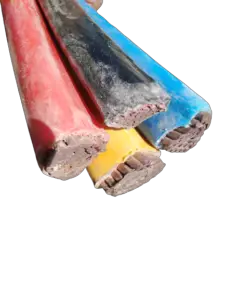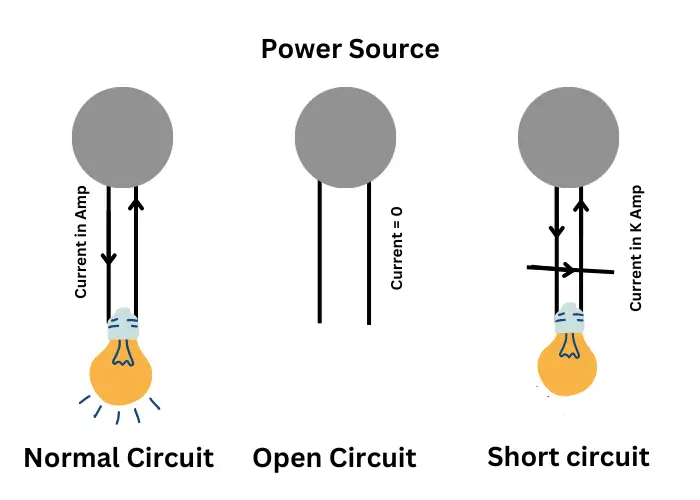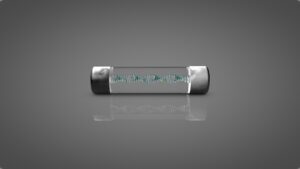An electrical short circuit occurs when an unintended low-resistance connection is established between two points in an electrical circuit, allowing a large current to flow. This bypasses the designed path of electricity, which is usually through a load (like an appliance or a light bulb).
In summary, a short circuit is dangerous because it can lead to fire, electrical shock, equipment damage, and even explosions, posing significant risks to people, property, and the environment.
Table of Contents
Why is an electrical short circuit dangerous?
An electrical short circuit is dangerous because it creates a situation where electrical current flows through an unintended path with little or no resistance, causing a range of hazardous outcomes. Here’s why it’s so risky:
1. Overheating
- A short circuit allows a large amount of current to flow through the circuit, far exceeding the circuit’s design limits.
- This excessive current generates intense heat in the wires, which can:
- Melt insulation, exposing live wires.
- Cause the wires themselves to overheat and fail.
2. Fire Hazard
- The intense heat generated during a short circuit can ignite nearby flammable materials, such as:
- Wood, plastics, or fabrics.
- This makes short circuits a leading cause of electrical fires in homes and workplaces.
3. Electrical Shock
- Damaged insulation or exposed wires resulting from a short circuit can lead to accidental contact with live electrical parts, increasing the risk of electrical shock to individuals nearby.
4. Equipment Damage
- Sensitive electrical devices connected to the circuit may be exposed to sudden voltage surges, causing:
- Irreversible damage.
- Expensive repairs or replacements.
5. Circuit Breaker or Fuse Failure
- While fuses or circuit breakers are designed to protect against short circuits, repeated or extreme faults can:
- Degrade protective devices over time, leaving the system vulnerable to future problems.
- Cause nuisance tripping, disrupting essential operations.
- In industrial environments with combustible materials or gases, a short circuit could create sparks that ignite an explosion.
What is The Bad Effect of a Short Circuit?
A short circuit can cause both heat-related (thermal) and physical (mechanical) damage to an electrical system, posing serious risks to people and property. Here’s how:
Thermal Effects
- Heat Generation:
A short circuit causes a sudden increase in current and a drop in resistance, producing a lot of heat in a very short time. - Overheating:
The intense heat can damage wires, melt insulation, and scorch surrounding materials, increasing the risk of fire. - Fire Hazard:
The excessive heat can ignite flammable materials nearby, such as wood, paper, or insulation, potentially leading to dangerous electrical fires.
Mechanical Effects
- Force and Pressure:
The high current flow creates strong electromagnetic forces, which can stress and damage wires, components, and even structures. - Arcing and Sparks:
Short circuits often produce arcs and sparks that can damage surfaces, wear down components, and increase the risk of further electrical failures. - Equipment Damage:
The physical forces from a short circuit can harm electrical devices, leading to costly repairs or replacements.
causes of short circuits

Short circuits can be caused by various factors, and they often result from a breakdown in the electrical insulation that is designed to keep conductors separated. Here are some common causes of short circuits:
-
Faulty Insulation: The most common cause of short circuits is faulty insulation around electrical conductors. Over time, insulation can deteriorate due to age, exposure to environmental factors, mechanical damage, or manufacturing defects. When the insulation breaks down or is compromised, it can allow conductors to come into contact with each other, leading to a short circuit.
-
Moisture and Water Intrusion: Moisture and water can penetrate electrical systems, causing short circuits. Water is a good conductor of electricity, and when it comes into contact with exposed conductors or connections, it can create a low-resistance path for electrical current to flow, resulting in a short circuit. Read my article Moisture the Hidden Killer of transformers.
-
Physical Damage: Mechanical damage to electrical wires and cables can expose conductors and lead to short circuits. This damage can occur during installation, maintenance, or due to physical stress from sources such as rodents or accidental impact.
-
Overloading: Excessive current in a circuit, often referred to as an overload, can generate heat that can melt the insulation and cause a short circuit. Overloading can occur when too many electrical devices are connected to a single circuit or when equipment malfunctions and draws more current than the circuit can handle.
-
Poor Workmanship: Incorrect wiring or electrical connections, such as improperly joined wires, loose connections, or incorrect terminations, can create short circuits. These issues can occur during installation or repair work if proper procedures and techniques are not followed.
-
Aging and Wear: Over time, electrical components can deteriorate due to aging, wear, and tear. This can result in insulation breakdown, degraded connections, and increased susceptibility to short circuits.
-
Environmental Factors: Extreme temperatures, exposure to chemicals, or exposure to UV radiation can degrade insulation and increase the risk of short circuits in outdoor or industrial environments.
Types of short circuit
Short circuits can be classified into different types based on the nature of the fault and the components involved. Here are the common types:
1. Line-to-Line Short Circuit
- Description: Occurs when two live (phase) conductors come into direct contact, bypassing the load.
- Causes: Faulty wiring, damaged insulation, or accidental contact between phases.
- Risks: High fault currents, severe heat generation, and potential equipment damage.
2. Line-to-Neutral Short Circuit
- Description: Happens when a live (phase) conductor contacts the neutral wire directly.
- Causes: Loose connections, broken insulation, or improper installations.
- Risks: Overcurrent in the circuit, potential tripping of breakers, and localized overheating.
3. Line-to-Ground Short Circuit
- Description: Occurs when a live (phase) conductor comes into contact with the ground (earth) or a grounded component.
- Causes: Faulty grounding, water intrusion, or accidental contact with conductive surfaces.
- Risks: Dangerous shock hazards and potential equipment damage.
4. Three-Phase Short Circuit
- Description: Involves all three-phase conductors in a fault condition, either directly or through a conductive path.
- Causes: Equipment failure, insulation breakdown, or mechanical damage.
- Risks: Extremely high fault currents, significant mechanical stress, and widespread system failure.
5. Bolted Short Circuit
- Description: A solid connection forms between conductors with little to no resistance.
- Causes: Improper installation, equipment malfunction, or direct metallic contact.
- Risks: Extremely high and rapid fault currents, leading to severe equipment and system damage.
6. Arcing Short Circuit
- Description: Involves a high-resistance connection, causing electrical arcing between conductors.
- Causes: Damaged insulation, loose connections, or contaminants like dust and moisture.
- Risks: Fire hazards, heat buildup, and gradual component degradation.
7. Symmetrical and Asymmetrical Short Circuits
- Symmetrical Short Circuit: The fault current is balanced and equal across all phases.
- Asymmetrical Short Circuit: The fault current is unbalanced, often involving unequal phases or ground faults.
Protection against electrical short circuit
Protection against electrical short circuits is crucial to ensure the safety of people, property, and the electrical system itself. Here are some key measures and devices used for protection against short circuits:
-
Circuit Breakers: Circuit breakers are automatic switches designed to detect and interrupt excessive current flow in a circuit. They are one of the primary protection devices against short circuits. Circuit breakers come in various types, including thermal-magnetic, magnetic, and electronic trip units, each with specific applications. When a short circuit occurs, the circuit breaker trips, opening the circuit and stopping the flow of current, thus preventing damage and hazards.
-
Fuses: Fuses are protective devices that contain a conductor that melts when subjected to excessive current. When a short circuit or overcurrent event occurs, the fuse element melts, opening the circuit and interrupting the flow of electricity. Fuses are commonly used in both residential and industrial electrical systems.
-
Ground Fault Circuit Interrupters (GFCIs): GFCIs are specialized devices used to protect against ground faults, which can lead to short circuits and electrical shocks. GFCIs monitor the balance of current between the hot and neutral conductors. If they detect an imbalance, they trip the circuit, cutting off power and preventing electrical hazards.
-
Arc Fault Circuit Interrupters (AFCIs): AFCIs are designed to detect dangerous arcing conditions in electrical circuits that can lead to short circuits and fires. They are particularly important in residential settings, where arcing can occur due to damaged wiring or loose connections in outlets and switches.
-
Short-Circuit Protection Relays: In industrial and high-power applications, protective relays are used to detect short circuits and other electrical faults. These relays can initiate actions such as tripping circuit breakers or isolating sections of the electrical system to prevent further damage.
-
Overcurrent Protection Devices: Overcurrent protection devices, including circuit breakers and fuses, are essential for limiting current to safe levels during short circuits and overloads. They are often sized and rated based on the maximum current-carrying capacity of the conductors they protect.
-
Proper Circuit Design: Proper electrical system design and layout can help prevent short circuits. This includes the correct sizing of conductors, the use of appropriate insulation materials, and the implementation of wiring practices that minimize the risk of contact between conductors.
-
Regular Inspections and Maintenance: Regular inspections of electrical systems by qualified professionals are essential to identify and address potential short-circuit hazards. Maintenance includes tightening connections, replacing worn or damaged components, and ensuring that insulation remains in good condition.
-
Equipment Grounding: Proper grounding of electrical equipment and systems helps to divert fault currents safely to the earth, reducing the risk of short circuits and electrical hazards.
-
Electrical Safety Training: Training for individuals working with electrical systems is critical to ensure they understand safe practices, including how to respond to short circuits and other electrical emergencies.
Can A Short Circuit Damage a Breaker?
Yes, a short circuit can potentially damage a circuit breaker, although circuit breakers are designed to protect against short circuits and other electrical faults. Here’s how it can happen:
-
Overcurrent Conditions: When a short circuit occurs, there is a rapid and substantial increase in electrical current flowing through the circuit. Circuit breakers are designed to detect these overcurrent conditions and open the circuit to interrupt the flow of electricity. In most cases, circuit breakers do their job effectively and protect the electrical system from damage.
-
Excessive Current Magnitude: Short circuits can generate extremely high levels of current, often far exceeding the normal operating current of the circuit. While circuit breakers are rated to handle specific levels of current, if the short circuit current surpasses the breaker’s rated capacity, it can potentially cause damage to the breaker.
-
Mechanical Stress: The rapid interruption of a high short circuit current can subject the internal components of a circuit breaker to mechanical stress. This stress can be particularly severe for high-current short circuits. Repeated mechanical stresses over time can lead to wear and tear on the breaker’s components.
-
Arcing and Erosion: Short circuits often produce electrical arcs, which can erode and pit the contacts and other components inside the breaker. This erosion can affect the breaker’s ability to make and break electrical connections reliably.
-
Arc Blast and Pressure: In some high-current short circuit events, the release of energy during the arc interruption can create an arc blast and high-pressure conditions within the breaker. This pressure can further stress the breaker’s internal components and potentially cause damage.
difference Between Short Circuits and Open Circuits

Short circuits and open circuits are two common electrical problems, but they are completely opposite in how they affect a circuit. Here’s a simple breakdown:
Short Circuit
- What it is:
A short circuit happens when a low-resistance path forms accidentally, allowing current to bypass the normal route in the circuit. - What happens to the current:
Current flows through the unintended path with almost no resistance, causing it to spike to very high levels. This can lead to overheating, equipment damage, or even fires. - Voltage:
Voltage drops significantly at the point of the short because the current bypasses the load. - Common causes:
- Damaged insulation.
- Faulty wiring or loose connections.
- Conductors touching each other or foreign objects bridging the circuit.
Open Circuit
- What it is:
An open circuit occurs when there’s a break or interruption in the electrical path, stopping the flow of current completely. - What happens to the current:
No current flows because the circuit is incomplete. - Voltage:
The voltage across the open circuit stays the same as the source voltage because no current is flowing. - Common causes:
- Broken or disconnected wires.
- Faulty switches left open.
- Damaged components or loose connections.
Key Difference
- A short circuit causes excessive current to flow along an unintended path, while an open circuit stops current flow entirely due to a break in the circuit.
- Both can cause issues in electrical systems and need specific solutions for repair.
Understanding these faults can help you identify problems in your circuits and take the right steps to fix them.
difference between overload and short circuit
The terms overload and short circuit both refer to electrical issues that can affect a system, but they are fundamentally different in their causes and effects. Here’s a simple explanation:
Overload
- Definition:
An overload happens when too many devices or loads are connected to a circuit, causing the current to exceed the circuit’s designed capacity. - Cause:
Plugging in too many appliances, running devices that draw excessive power, or faulty equipment. - Effect on Current:
The current is higher than normal but still flows through the intended path. - Risks:
Overheating of wires and components, which can lead to insulation damage and fire hazards over time. - Protection:
Circuit breakers or fuses are designed to trip or blow when current exceeds safe levels.
Short Circuit
- Definition:
A short circuit occurs when a low-resistance, unintended path is created, bypassing the normal load. - Cause:
Faulty wiring, damaged insulation, or physical contact between conductors (e.g., live and neutral wires touching). - Effect on Current:
The current spikes dramatically because the low resistance allows a large current to flow instantly. - Risks:
Immediate overheating, sparks, arcing, and the potential for electrical fires or explosions. - Protection:
Circuit breakers or fuses are also designed to trip or blow, but they respond much faster to short circuits than to overloads.
Key Differences
| Aspect | Overload | Short Circuit |
|---|---|---|
| Cause | Too many loads or devices connected | Faulty wiring or conductor contact |
| Path | Current flows through the correct path | Current flows through an unintended path |
| Current Level | Higher than normal, but manageable | Extremely high, dangerous levels |
| Risks | Gradual overheating, long-term damage | Immediate overheating, sparks, fire |
| Response Time | Slower trip of breaker/fuse | Instant trip of breaker/fuse |
Summary
- Overload: Too much current through the right path.
- Short Circuit: Excessive current through the wrong path.
Both can be dangerous, but short circuits are typically more immediate and severe. Proper protective devices and regular system checks can help prevent both issues.
Don’t Leave Empty-Handed!
Install my Free Android App on Google Play:
Electrical Cables Most Common Tables “Cables Tables”
And, my Electrical Calculations App “Fast Electrical Calculator”
Discover more great content by subscribing to My channel
Looking to stay ahead of the game in the world of electrical engineering? Subscribe to my YouTube channel and gain access to exclusive content you won’t find anywhere else!
The staff I recommend
(Amazon Affiliate Links to products I believe are high quality):
- Economy 120 Volt/60Hz AC Power Source – Step-Down Voltage & Frequency Converters 1800W
- UNI-T Digital Multimeter Tester UT139C
- 50-Amp Extension Cord for RV “100ft”
- Voltage Stabilizer 110/220v
- Hair Dryer “best selling“
- TOSHIBA EM131A5C-BS Countertop Microwave Ovens
Disclaimer: This contains affiliate links to Amazon products. I may earn a commission for purchases made through these links.


